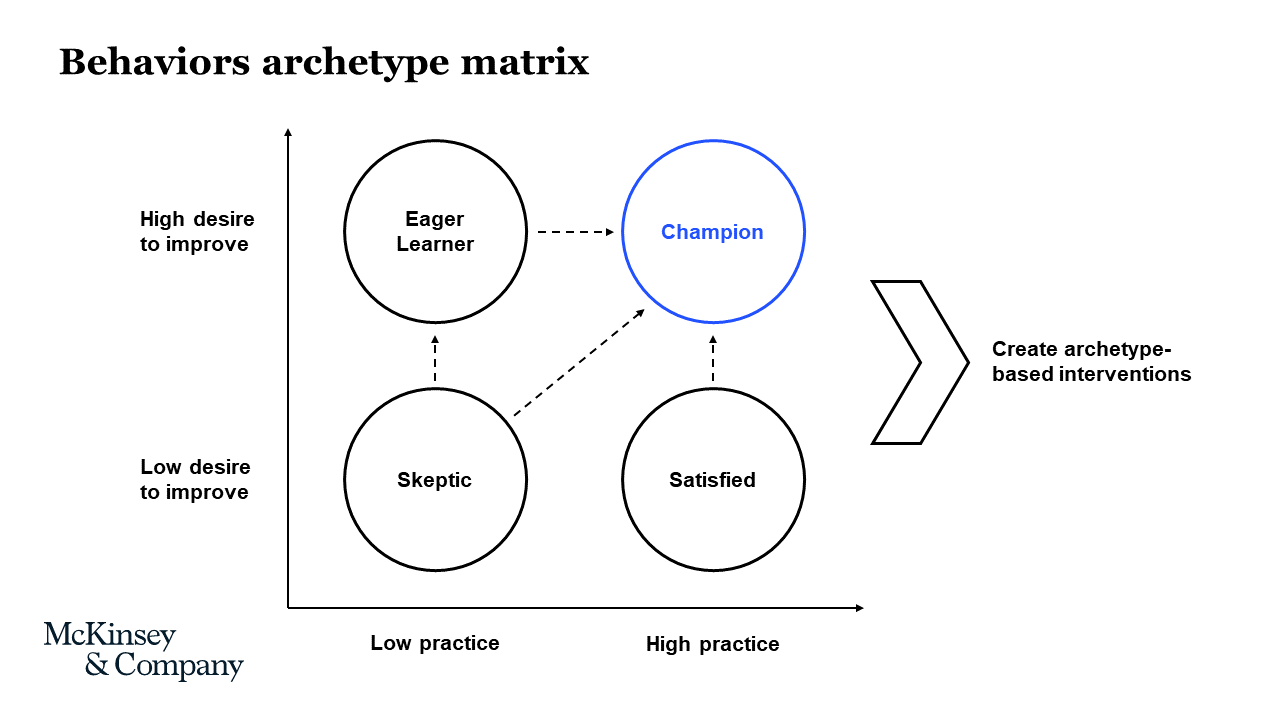Leaders face a growing need to assess organizational capabilities and implement transformative strategies to ensure sustained success. Yet, in many cases, organizations miss the mark when it comes to creating enduring and impactful change, and it’s costing them. One McKinsey survey found that less than one-third of respondents say their company’s transformation has been successful at both improving organizational performance and sustaining those improvements over time. This failure to create sustainable behavior shifts often stems from a fundamental misunderstanding of how to effectively deliver capability-building programs, a crucial component of any change effort.
Simply put, the conventional ‘one-size fits all’ approach to capability building is outdated. It forces homogony where there is complexity, and it does little to account for employees as individual learners or their differing mindsets, needs, and engagement preferences.
A blanket approach to capability building has the potential to leave many uninterested or unwilling to learn and implement new skills. Absent a tailored approach to capability building, only 10 percent of organizations believe capability-building initiatives have business impact, and 63 percent of change efforts fail to successfully improve and sustain impact. To better meet learners where they are, archetyping is a helpful tool to segment populations and understand their convictions and mindsets. It can also be used to create a more contextual and targeted approach to capability building that ultimately leads to enduring organizational change.
While there are many ways to segment learner populations, one of the most foundational approaches is to determine the existing frequency of practice of desired behaviors and the conviction to improve on those behaviors. The behaviors archetype matrix (exhibit 1) allows us to understand not only what learners are lower on their adoption of new behaviors, but to also gauge why they are low—e.g., is it because they don’t have the desire to improve (Skeptics), or that they want to improve but don’t take the time to practice and adopt new skills (Eager Learners)? These archetypes require different interventions to increase the odds of capability-building success. Early results show that 26 percent of capability-building participants prior to the start of a program self-identify as Skeptics.1

Learner archetyping allows organizations to find a more effective way to change the behaviors of those with a low desire to improve or practice. It also helps identify the Champions who can role model the capabilities being taught. Our data shows that Champions outperformed other archetypes in three behavior areas: project planning frequency, percentage of tasks completed, and excitement to grow within the organization. More than 50 percent of individuals who had significant improvement in these areas were Champions.2
One financial services organization saw their Champions improve disproportionally compared to other archetypes when looking at three distinct skill areas. Before their capability-building journey, 24 percent of people in the organization were categorized as Champions. When measured again after the journey, Champions represented 49 percent of those who reported running meetings more effectively, 50 percent of those who reported communicating regularly with increased clarity, and 66 percent of those who reported dedicating time to develop new ideas. The relationship between Champions and improvement across sustained capabilities underscores the critical role of measuring and fostering a Champion’s mindset across the organization.
I think the skill building that we’ve done with McKinsey has built confidence in employees. I think that they know they can do more. They’re thinking about their careers differently. They’re using the language that we learned from McKinsey. We sent all of our employees through the classes. So, I think they’re really bringing it to life.
McKinsey’s influence model describes four crucial factors needed for behavior change, one of which is role modeling. This is where Champions play a key role in ensuring that new behaviors cascade across the organization through the power of example. Role modeling is often ascribed to what leaders can do to drive change efforts, but it should not stop there. Cultivating a network of Champions across all levels of the organization creates day-to-day norms out of the new capabilities—ensuring they become the default rather than the exception. In fact, organizations that engage these Champions to naturally influence other employees to change are almost four times as likely to see their efforts succeed.
Leveraging learner archetyping to deliver contextual interventions ultimately increases the odds of turning newly taught capabilities into sustained behaviors for the organization. Meeting learners where they are creates an environment that is conducive to changing their motivations and mindsets.
While the first step is archetyping, the necessary second step is approaching these archetypes with interventions that uniquely address their individual mindsets. Champions need to be celebrated, Eager Learners need to be given the tools to turn into Champions, Skeptics need their convictions reset, and the Satisfied need to expand a continuous improvement mindset.
With the lofty yet worthwhile aspiration of converting all employees to Champions, organizations have the key ingredient in creating a self-sustaining ecosystem where new behaviors can become the norm rather than the exception.
The authors wish to thank Jenna Brayton, Sherry Heffner, Sebastian Rodriguez, Busra Sertalp, and Joachim Talloen for their contributions.
1 McKinsey survey data pre-program survey of A2E Essentials participants
2 McKinsey survey data from respondents comparing A2E Essentials pre and post program reflections



